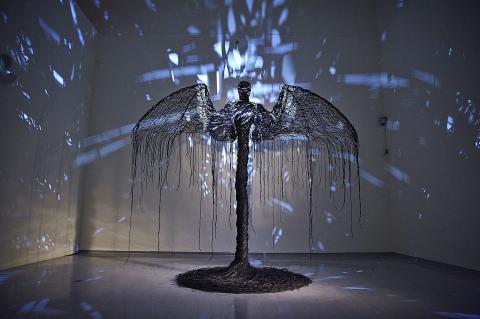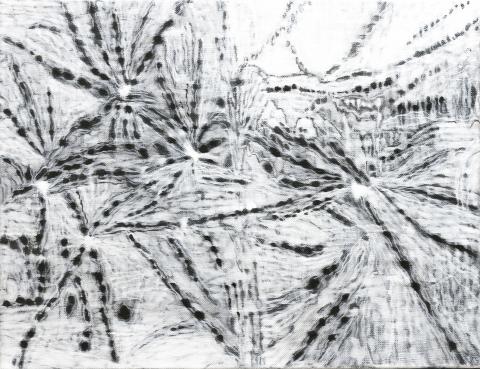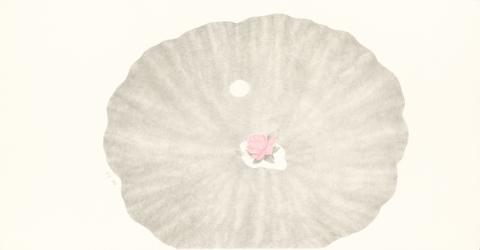This week, Taiwan’s art scene mostly focuses on happenings in Taichung, kicking off with Art Taichung. In its fifth edition, the hotel art fair is spread across five floors and features 57 galleries, including Japan’s Gallery Kogure and Gallery Woo from South Korea, while Taiwan’s premium galleries and young spaces will survey the nation’s contemporary art scene. This year’s theme is sculpture and how people encounter public art in the city as well as the relation to how visitors view sculptures at an art fair. Special showcases include “Concepts and Status — A Special Exhibition of New Media Art” and “Young Voices.”
■ Millennium Hotel Taichung (台中日月千禧酒店), 77 Shizheng Rd, Taichung City (台中市市政路77號), tel: (04) 3705-6000.
■ Until Sunday from noon to 7pm

Photo courtesy of Soka Art Center
Chen Nien-tzu’s (陳念慈) delicate ink painting’s on paper are among the highlights of the group show, Insight into the Nature of Mind — The New Trace of Contemporary ink Art (觀心 — 當代水墨的新足跡). Chen’s seemingly realistic subjects are depicted by omission. In Moonlight, for example, the moon is not depicted directly, but through the reflection that plays with the perception of existence. Winnie Mak’s (麥翠影) traditional ink sketches are hypnotic meditations on people.
■ Da Xiang Art Space (大象藝術空間館), 15 Boguan Rd, Taichung City (台中市博館路15號), tel: (04) 2208-4288. Open Tuesdays to Sundays from noon to 8pm
■ Until Aug. 20

Photo courtesy of National Taiwan Museum of Fine Arts
Nick Dong’s (董承濂) installations are the result of meticulous designs that emphasize the beauty of light and reflection. In his solo show, Specular Reflection (鏡中實相), the artist delves into that space between reality and the unknown.
Visitors to the exhibition stil laif (靈魂機械鍊金術) will see Korean artist Choe U-ram’s (崔旴嵐) elegant mechanical installations. Choe’s ongoing investigation of the relationship between living organisms and machinery forms an interesting dialogue with Nick Dong’s works.
■ National Taiwan Museum of Fine Arts (國立臺灣美術館), 2, Wuquan W Rd Sec 1, Taichung City (台中市西區五權西路一段2號) tel: (04) 2372-3552, open Tuesdays to Fridays from 9am to 5pm, Saturdays and Sundays from 9am to 6pm

Photo courtesy of Ke-Yuan Gallery
■ Both exhibitions run until Sept. 3
Lee Meng’s (李檬) acrylic paintings have a strong focus on nature — more specifically, leaves — that are infused with a literati sensibility, giving rise to a novel form of the still life genre. The Green Breath (清涼吐納) suggests a strong duality of finding peace and relaxation — perhaps the reason her works are so appealing.
■ Ke-Yuan Gallery (科元藝術中心), 3-4F, 126-8 ChongShan Rd, Taichung City (台中市中山路126-8號3-4樓), tel: (04) 2622-9706. Open Tuesdays to Sundays from 11am to 6pm

Photo courtesy of Yami Art Space
■ Until July 30
Cheng Hsien-yu (鄭先喻) presents Collector (收集者), which shows a series of odd mechanical structures, such as an installation of electric mosquito lamps connected to a gaming device with small insects. These futuristic works were made when the artist was living in the Netherlands from 2009 to 2013.
■ Yiri Arts Taichung (伊日藝術台中空間), 2 Jingcheng 5th St, Taichung City (台中市精誠五街2號), tel: (04) 2327-4361. Open Tuesdays to Sundays from 1pm to 7pm

Photo courtesy of Da Xiang Art Space
■ Until Aug. 13
At The Endless Journey (無盡的旅程), Chen Shao-yen’s (陳劭彥) acrylic paintings, which appear to be ink on paper, will confound and fascinate in equal measure. Malaysian artist Tan Kent-keong (陳傑強) will show his oil paintings, which are imbued with a sense of the passing of time.
■ Yami Art Space (亞米藝術), 8, Aly 66, Ln 79, Sec 1, Xiangshang Rd, Taichung City (台中市向上路一段79巷66弄8號), tel: (04) 2301-2252. Open Tuesdays to Saturdays from 10am to 7pm

Photo courtesy of Soka Art Center
■ Until July 29
Daniel Eskenazi will present his first solo exhibition TIME/LIGHT (時/光). The use of Eskenazi’s long exposure photographs of natural patterns found in organisms like seashells and insects are gateways to further discovering the authenticity of the world as a philosophical experimentation.
■ Soka Art Center (索卡藝術中心), 350 Tiding Blvd Sec 2, Taipei City (台北市堤頂大道二段350號), tel: (02) 2533-9658. Open Tuesdays to Sundays from 10 am to 7pm
■ Opening reception tomorrow at 4pm; until Sept. 3

When Taiwan was battered by storms this summer, the only crumb of comfort I could take was knowing that some advice I’d drafted several weeks earlier had been correct. Regarding the Southern Cross-Island Highway (南橫公路), a spectacular high-elevation route connecting Taiwan’s southwest with the country’s southeast, I’d written: “The precarious existence of this road cannot be overstated; those hoping to drive or ride all the way across should have a backup plan.” As this article was going to press, the middle section of the highway, between Meishankou (梅山口) in Kaohsiung and Siangyang (向陽) in Taitung County, was still closed to outsiders

President William Lai (賴清德) has championed Taiwan as an “AI Island” — an artificial intelligence (AI) hub powering the global tech economy. But without major shifts in talent, funding and strategic direction, this vision risks becoming a static fortress: indispensable, yet immobile and vulnerable. It’s time to reframe Taiwan’s ambition. Time to move from a resource-rich AI island to an AI Armada. Why change metaphors? Because choosing the right metaphor shapes both understanding and strategy. The “AI Island” frames our national ambition as a static fortress that, while valuable, is still vulnerable and reactive. Shifting our metaphor to an “AI Armada”

US President Donald Trump may have hoped for an impromptu talk with his old friend Kim Jong-un during a recent trip to Asia, but analysts say the increasingly emboldened North Korean despot had few good reasons to join the photo-op. Trump sent repeated overtures to Kim during his barnstorming tour of Asia, saying he was “100 percent” open to a meeting and even bucking decades of US policy by conceding that North Korea was “sort of a nuclear power.” But Pyongyang kept mum on the invitation, instead firing off missiles and sending its foreign minister to Russia and Belarus, with whom it

The Chinese Communist Party (CCP) has a dystopian, radical and dangerous conception of itself. Few are aware of this very fundamental difference between how they view power and how the rest of the world does. Even those of us who have lived in China sometimes fall back into the trap of viewing it through the lens of the power relationships common throughout the rest of the world, instead of understanding the CCP as it conceives of itself. Broadly speaking, the concepts of the people, race, culture, civilization, nation, government and religion are separate, though often overlapping and intertwined. A government